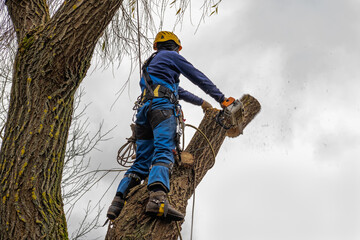Tree Removal can improve the aesthetics of your property and enhance outdoor living spaces. It can also improve airflow and add usable square footage to your landscape.
Homeowners who opt for Tree Removing should prepare the area before the service begins by clearing out space and removing any children or pets from the vicinity. Visit https://www.worcestertreeremovalservice.com/ to learn more.
 Trees add value to residential and commercial landscapes by providing aesthetic, environmental, and functional benefits. However, when trees become hazardous due to disease or damage, it is often necessary to remove them. This process can be dangerous and require the expertise of a professional arborist. This is especially true for tall and large trees that are located close to houses, roads, power lines, or other structures. Performing this work without proper knowledge or equipment can cause significant damage, injuries, and even death.
Trees add value to residential and commercial landscapes by providing aesthetic, environmental, and functional benefits. However, when trees become hazardous due to disease or damage, it is often necessary to remove them. This process can be dangerous and require the expertise of a professional arborist. This is especially true for tall and large trees that are located close to houses, roads, power lines, or other structures. Performing this work without proper knowledge or equipment can cause significant damage, injuries, and even death.
Fortunately, there are steps that can be taken to ensure the safety of homeowners and professionals who perform this type of work. The first step involves assessing the condition of the tree and its surroundings. This evaluation includes looking at the tree’s health, structural integrity, and its proximity to buildings or utility lines. It also focuses on the potential direction of the tree’s fall. Once this assessment has been completed, it is possible to select the best removal technique.
The next step is to prepare the work area. This includes establishing barriers to keep bystanders at a safe distance and securing the site with appropriate tools and equipment. It is also important to make sure that any breakable items are moved away from the area. If they are left near the work area, they could be knocked over or damaged by falling limbs. It is also a good idea to have an escape route for yourself and any others who may be working on the tree.
Finally, it is important to inform neighbors of the impending removal. If they have been using the tree for shade or privacy, it would be a good idea to let them know in advance so that they can plant their own trees or use another means of achieving these benefits.
While there are many benefits to tree removal, it is important to understand the risks involved. It is always a better option to hire a professional rather than attempting the work on your own. In addition to ensuring the safety of all who are working on the tree, this will help protect your property and reduce the likelihood of damage or injury to others.
Health
A healthy tree is a key component of a beautiful landscape. However, several circumstances call for a tree to be removed from your property, including if it’s dying or infested; has been damaged during a storm; is obstructing your home or business’s view; or is taking up valuable space that could be used for other purposes. Attempting to remove a diseased, dead, or dangerous tree without the proper equipment can be extremely hazardous for your family and property.
When performing tree removal, expert arborists take a number of preventive measures to guarantee the safety and success of the process. These include a thorough assessment and planning phase, which provides information about the size, health, and species of the trees involved in the project. This allows them to determine the most precise methods for felling and removing the trees while considering environmental impact and safety measures.
During this phase, the professional arborist will also look for a number of potential issues that may require immediate attention. This includes signs of insect infestation, fungi presence, and withered leaves. It’s important to catch any of these problems early, as they can lead to the decline and eventual death of a healthy tree.
Additionally, the professional arborist will examine the surrounding area of the trees for any potential hazards that could jeopardize the success of the tree removal. These issues can include obstructions, such as wires, power lines, or other structures that could pose a threat to the safety of workers and those in the vicinity of the work zone.
Other preventive measures for a successful tree removal project include removing grass from the area underneath a tree’s canopy, which eliminates the need to mow under the tree and reduces injury to the trunk of the tree. This can also help the soil beneath a tree by eliminating competition from grass roots for water and nutrients, promoting greater root growth.
Another preventive measure is removing girdling roots, which can choke off the flow of water and nutrients from the root collar to the rest of the tree, causing it to weaken and die. This can be caused by excessive pruning, topping, mowing, mulching, trenching, excavation, and improper soil grading around a tree, among other things.
Curb Appeal
Whether you’re thinking of selling your property anytime soon or simply want to improve its aesthetic, you should consider working with a tree service. Creating a more beautiful landscape and boosting your home’s curb appeal can be a rewarding project that brings a sense of pride and fulfillment when it’s complete.
Curb appeal is the initial impression that a person gets about your home or property from their first glance at it. It’s a big factor in whether or not a person wants to take a closer look, set up an appointment for a tour, or even scroll past your listing online. The term is often thrown around in the real estate world, and it’s true that a well-maintained exterior can increase your property value.
The key to creating a good first impression is to make sure your landscaping is in great condition and that any eyesores are removed. This can be as simple as moving parked cars (important before a showing or open house), putting away bikes, or discarding broken decor. It can also include cleaning up the front door and porch area, painting a mailbox, or adding a fresh, clean doormat to welcome guests.
As the largest flora on any property, trees can make a significant impact on your landscape’s overall curb appeal. They add natural beauty, help with noise and temperature regulation, and promote healthy soil for new planting opportunities. They can even add more usable square footage to your outdoor space by offering shade and privacy from neighboring properties.
While all of the tips and tricks you can find on social media and in reality TV shows can certainly help, it’s important to remember that the most valuable way to boost your curb appeal is with proper care and maintenance. Proper maintenance of your trees includes regular pruning, stump removal, and yard cleanups. By incorporating these measures into your routine, you’ll be on your way to a more attractive and appealing property in no time. Having curb appeal is a wonderful way to show that you care about your property and enjoy the benefits it offers.
Stump Removal
Stumps are an eyesore, a trip hazard and can even interfere with your landscape and landscaping. Performing stump removal is an additional process to tree removal and requires its own special equipment. A stump grinder is used to grind a tree trunk into small pieces, leaving behind a mulch-like material that can be incorporated into your landscaping or removed completely. This is a labor-intensive process that can require heavy machinery or the help of a professional tree service.
Before stump grinding, the area around a stump should be cleared. This allows the machine to reach the roots, which may be hidden underneath a layer of dirt. A shovel, pick mattock or digging bar can also be used to expose the roots and cut them at their base. This will make the stump easier to remove.
Larger, older stumps can prove incredibly difficult to get rid of. They’re more likely to have extensive roots that extend far into the ground, making them a tripping or falling hazard. They can also be hard to dig out using a shovel. Stump grinding is often the best solution for these types of stubborn stumps.
Homeowners can also use a chemical stump remover to soften a stubborn stump and make it easier to manually break apart and pull out. This is a more environmentally-friendly option than burning a stump, but it can take weeks to work. It also can be dangerous, as some stump remover chemicals are toxic to animals and plants if over-applied.
Despite the many advantages of removing a tree stump, the process can be time-consuming and expensive. Some homeowners attempt to save money and time by doing the work themselves, but this is a risky proposition that should be avoided at all costs. A professional will ensure that not only is the stump but the entire root system are completely removed to prevent regrowth and potential hazards.
Homeowners should always check with their city or county planning department to see if there are any specific stipulations on which trees can be removed, including whether a permit is required. This can be especially important for larger stumps that are located near homes or interfering with utility lines.


